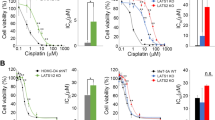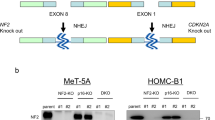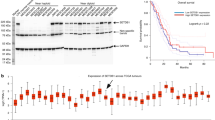Abstract
Mesothelioma is diagnosed in ∼2500 patients in the United States every year, most often arising in the pleural space, but also occurring as primary peritoneal mesothelioma. The vast majority of patients with mesothelioma die of their disease within 3 years. We developed a new mouse model of mesothelioma by bladder or intraperitoneal injection of adenovirus Cre into mice with conditional alleles of each of Tp53 and Tsc1. Such mice began to develop malignant ascites about 6 months after injection, which was due to peritoneal mesothelioma, on the basis of tumor morphology and immunohistochemical staining. Mesothelioma cell lines were established, which showed loss of both Tsc1 and Tp53, with mammalian target of rapamycin complex (mTORC)1 activation. Treatment of mice with malignant ascites due to mesothelioma with rapamycin led to a marked reduction in ascites, extended survival and a 95–99% reduction in the mesothelioma tumor volume, in comparison with vehicle-treated mice. To see whether TSC1/TSC2 loss was a common genetic event in human mesothelioma, we examined nine human mesothelioma cell lines, and found that four of nine showed persistent activation of mTORC1, although none had loss of TSC1 or TSC2. A tissue microarray analysis of 198 human mesothelioma specimens showed that 33% of cases had reduced TSC2 expression and 60% showed activation of mTOR, indicating that mTOR activation is common in human mesothelioma, suggesting that it is a potential therapeutic target.
This is a preview of subscription content, access via your institution
Access options
Subscribe to this journal
Receive 50 print issues and online access
$259.00 per year
only $5.18 per issue
Buy this article
- Purchase on Springer Link
- Instant access to full article PDF
Prices may be subject to local taxes which are calculated during checkout







Similar content being viewed by others
References
Ettinger DS, Akerley W, Borghaei H, Chang A, Cheney RT, Chirieac LR et al. Malignant pleural mesothelioma. J Natl Compr Canc Netw 2012; 10: 26–41.
Tsao AS, Wistuba I, Roth JA, Kindler HL . Malignant pleural mesothelioma. J Clin Oncol 2009; 27: 2081–2090.
Vogelzang NJ, Rusthoven JJ, Symanowski J, Denham C, Kaukel E, Ruffie P et al. Phase III study of pemetrexed in combination with cisplatin versus cisplatin alone in patients with malignant pleural mesothelioma. J Clin Oncol 2003; 21: 2636–2644.
Kwiatkowski DJ, Thiele E, Whittemore VH . Tuberous sclerosis complex. Wiley-VCH, Weinheim, Germany, 2010. 3–7.
Jiao Y, Shi C, Edil BH, de Wilde RF, Klimstra DS, Maitra A et al. DAXX/ATRX, MEN1, and mTOR pathway genes are frequently altered in pancreatic neuroendocrine tumors. Science 2011; 331: 1199–1203.
Platt FM, Hurst CD, Taylor CF, Gregory WM, Harnden P, Knowles MA . Spectrum of phosphatidylinositol 3-kinase pathway gene alterations in bladder cancer. Clin Cancer Res 2009; 15: 6008–6017.
Qin W, Bajaj V, Malinowska I, Lu X, MacConaill L, Wu CL et al. Angiomyolipoma have common mutations in TSC2 but no other common genetic events. PLoS One 2011; 6: e24919.
Wagner AJ, Malinowska-Kolodziej I, Morgan JA, Qin W, Fletcher CD, Vena N et al. Clinical activity of mTOR inhibition with sirolimus in malignant perivascular epithelioid cell tumors: targeting the pathogenic activation of mTORC1 in tumors. J Clin Oncol 2010; 28: 835–840.
Hammerman PS, Hayes DN, Wilkerson MD, Schultz N, Bose R, Chu A et al. Comprehensive genomic characterization of squamous cell lung cancers. Nature 2012; 489: 519–525.
Dickson MA, Schwartz GK, Antonescu CR, Kwiatkowski DJ, Malinowska IA . Extrarenal perivascular epithelioid cell tumors (PEComas) respond to mTOR inhibition: clinical and molecular correlates. Int J Cancer 2012; 132: 1711–1717.
Iyer G, Hanrahan AJ, Milowsky MI, Al-Ahmadie H, Scott SN, Janakiraman M et al. Genome sequencing identifies a basis for everolimus sensitivity. Science 2012; 338: 221.
Menges CW, Sementino E, Talarchek J, Xu J, Chernoff J, Peterson JR et al. Group I p21-activated kinases (PAKs) promote tumor cell proliferation and survival through the AKT1 and Raf-MAPK pathways. Mol Cancer Res 2012; 10: 1178–1188.
Altomare DA, You H, Xiao GH, Ramos-Nino ME, Skele KL, De Rienzo A et al. Human and mouse mesotheliomas exhibit elevated AKT/PKB activity, which can be targeted pharmacologically to inhibit tumor cell growth. Oncogene 2005; 24: 6080–6089.
Goto J, Talos DM, Klein P, Qin W, Chekaluk YI, Anderl S et al. Regulable neural progenitor-specific Tsc1 loss yields giant cells with organellar dysfunction in a model of tuberous sclerosis complex. Proc Natl Acad Sci USA 2011; 108: E1070–E1079.
Auricchio N, Malinowska I, Shaw R, Manning BD, Kwiatkowski DJ . Therapeutic trial of metformin and bortezomib in a mouse model of tuberous sclerosis complex (TSC). PLoS One 2012; 7: e31900.
Liang MC, Ma J, Chen L, Kozlowski P, Qin W, Li D et al. TSC1 loss synergizes with KRAS activation in lung cancer development in the mouse and confers rapamycin sensitivity. Oncogene 2010; 29: 1588–1597.
Thoreen CC, Kang SA, Chang JW, Liu Q, Zhang J, Gao Y et al. An ATP-competitive mammalian target of rapamycin inhibitor reveals rapamycin-resistant functions of mTORC1. J Biol Chem 2009; 284: 8023–8032.
Menon S, Manning BD . Common corruption of the mTOR signaling network in human tumors. Oncogene 2008; 27 (Suppl 2): S43–S51.
Bianchi AB, Mitsunaga SI, Cheng JQ, Klein WM, Jhanwar SC, Seizinger B et al. High frequency of inactivating mutations in the neurofibromatosis type 2 gene (NF2) in primary malignant mesotheliomas. Proc Natl Acad Sci USA 1995; 92: 10854–10858.
Sekido Y, Pass HI, Bader S, Mew DJ, Christman MF, Gazdar AF et al. Neurofibromatosis type 2 (NF2) gene is somatically mutated in mesothelioma but not in lung cancer. Cancer Res 1995; 55: 1227–1231.
Suzuki Y, Murakami H, Kawaguchi K, Tanigushi T, Fujii M, Shinjo K et al. Activation of the PI3K-AKT pathway in human malignant mesothelioma cells. Mol Med Report 2009; 2: 181–188.
Hoda MA, Mohamed A, Ghanim B, Filipits M, Hegedus B, Tamura M et al. Temsirolimus inhibits malignant pleural mesothelioma growth in vitro and in vivo: synergism with chemotherapy. J Thorac Oncol 2011; 6: 852–863.
Opitz I, Soltermann A, Abaecherli M, Hinterberger M, Probst-Hensch N, Stahel R et al. PTEN expression is a strong predictor of survival in mesothelioma patients. Eur J Cardiothorac Surg 2008; 33: 502–506.
Brevet M, Shimizu S, Bott MJ, Shukla N, Zhou Q, Olshen AB et al. Coactivation of receptor tyrosine kinases in malignant mesothelioma as a rationale for combination targeted therapy. J Thorac Oncol 2011; 6: 864–874.
Jagadeeswaran R, Ma PC, Seiwert TY, Jagadeeswaran S, Zumba O, Nallasura V et al. Functional analysis of c-Met/hepatocyte growth factor pathway in malignant pleural mesothelioma. Cancer Res 2006; 66: 352–361.
Wilson SM, Barbone D, Yang TM, Jablons DM, Bueno R, Sugarbaker DJ et al. mTOR mediates survival signals in malignant mesothelioma grown as tumor fragment spheroids. Am J Respir Cell Mol Biol 2008; 39: 576–583.
Meikle L, Pollizzi K, Egnor A, Kramvis I, Lane H, Sahin M et al. Response of a neuronal model of tuberous sclerosis to mammalian target of rapamycin (mTOR) inhibitors: effects on mTORC1 and Akt signaling lead to improved survival and function. J Neurosci 2008; 28: 5422–5432.
Reddel RR, Malan-Shibley L, Gerwin BI, Metcalf RA, Harris CC . Tumorigenicity of human mesothelial cell line transfected with EJ-ras oncogene. J Natl Cancer Inst 1989; 81: 945–948.
Lopez-Lago MA, Okada T, Murillo MM, Socci N, Giancotti FG . Loss of the tumor suppressor gene NF2, encoding merlin, constitutively activates integrin-dependent mTORC1 signaling. Mol Cell Biol 2009; 29: 4235–4249.
James MF, Han S, Polizzano C, Plotkin SR, Manning BD, Stemmer-Rachamimov AO et al. NF2/merlin is a novel negative regulator of mTOR complex 1, and activation of mTORC1 is associated with meningioma and schwannoma growth. Mol Cell Biol 2009; 29: 4250–4261.
Kwiatkowski DJ, Zhang H, Bandura JL, Heiberger KM, Glogauer M, el-Hashemite N et al. A mouse model of TSC1 reveals sex-dependent lethality from liver hemangiomas, and up-regulation of p70S6 kinase activity in Tsc1 null cells. Hum Mol Genet 2002; 11: 525–534.
Marino S, Vooijs M, van Der Gulden H, Jonkers J, Berns A . Induction of medulloblastomas in p53-null mutant mice by somatic inactivation of Rb in the external granular layer cells of the cerebellum. Genes Dev 2000; 14: 994–1004.
Seager C, Puzio-Kuter AM, Cordon-Cardo C, McKiernan J, Abate-Shen C . Mouse models of human bladder cancer as a tool for drug discovery. Curr Protoc Pharmacol 2010, Chapter 14: Unit14 14.
Penno MB, Askin FB, Ma H, Carbone M, Vargas MP, Pass HI . High CD44 expression on human mesotheliomas mediates association with hyaluronan. Cancer J Sci Am 1995; 1: 196–203.
Burt BM, Rodig SJ, Tilleman TR, Elbardissi AW, Bueno R, Sugarbaker DJ . Circulating and tumor-infiltrating myeloid cells predict survival in human pleural mesothelioma. Cancer 2011; 117: 5234–5244.
Acknowledgements
We thank Dr Nathanael Gray (Dana Farber Cancer Institute, Boston, MA, USA) for kindly providing mTOR inhibitor Torin1 used in this study. This work was supported by Grants 1P01CA120964 and 2P50CA090578 from the National Institutes of Health, and the Chip Thayer Fund.
Author information
Authors and Affiliations
Corresponding author
Ethics declarations
Competing interests
The authors declare no conflicts of interest.
Additional information
Supplementary Information accompanies this paper on the Oncogene website
Supplementary information
Rights and permissions
About this article
Cite this article
Guo, Y., Chirieac, L., Bueno, R. et al. Tsc1-Tp53 loss induces mesothelioma in mice, and evidence for this mechanism in human mesothelioma. Oncogene 33, 3151–3160 (2014). https://doi.org/10.1038/onc.2013.280
Received:
Revised:
Accepted:
Published:
Issue Date:
DOI: https://doi.org/10.1038/onc.2013.280



